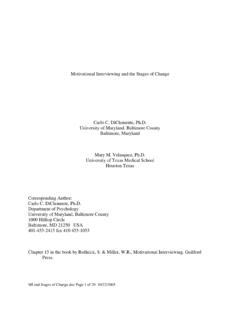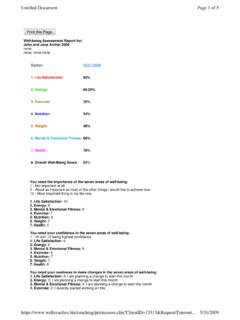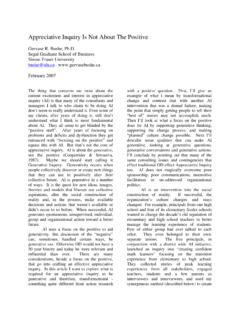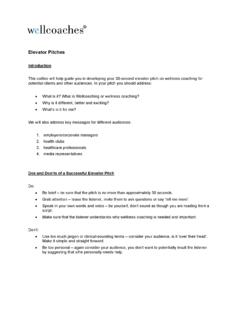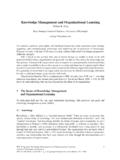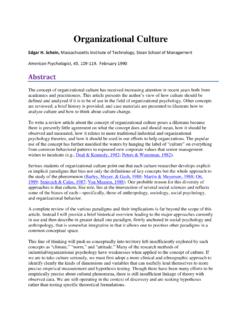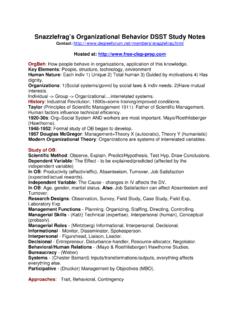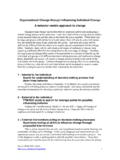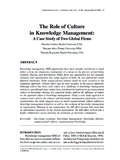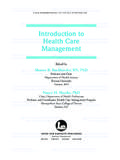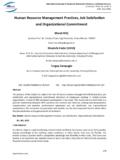Transcription of c 2007 Lippincott Williams & Wilkins, Inc. …
1 LWW/FCHLWWJ282-07 November 17, 200622:5 Char Count= 0 Fam Community HealthSupplement 1 to Vol. 30, No. 1S, pp. S64 S74c 2007 Lippincott Williams & wilkins , Health BehaviorChange Using AppreciativeInquiryMoving From Deficit Models toAffirmation Models of CareShirley M. Moore, PhD, RN; Jacqueline Charvat, MSThis article describes a new theoretical approach to health promotion and behavior change thatmay be especially suited to underserved women. Appreciative inquiry (AI), an organizational de-velopment process that focuses on the positive and creative as a force for an improved future, isdescribed and adapted for use as an intervention to achieve health behavior change at the individ-ual level.
2 Guiding principles for its use with clients are provided, and an example of its applicationis illustrated in a hypothetical case study of an African American woman of low-socioeconomicresources who is attempting to increase lifestyle exercise following a cardiac event. AI is con-trasted with the more traditional problem-solving approaches to the provision of care. The advan-tages, challenges, and issues associated with the use of AI as a health behavior change strategyare words:appreciative inquiry,health behavior change,health promotion,problem-solving approachNEW approaches to health behaviorchange are needed.
3 On the whole, therehas been limited effectiveness of interven-tions in producing lasting health ,2At best, health professionals havehad only minimal success at assisting individ-uals to adopt and sustain healthy 5 Current health behavior change models arebuilt predominately on philosophies that sug-gest that not using a particular behavior is aFrom Frances Payne Bolton School of Nursing, CaseWestern Reserve University, Cleveland, authors thank the members of the 2005 Institute forHealthcare Improvement Education Leadership Meet-ing and the 2006 Center for Health Promotion/DiseasePrevention Research (CHPR) in Underserved Popula-tions Collaboratory for their helpful comments in thedevelopment of the ideas presented in the author: Shirley M.
4 Moore, PhD, RN,Frances Payne Bolton School of Nursing, Case West-ern Reserve University, Cleveland, OH 44106 or a problem to be 9 This arti-cle describes a new philosophical approach topromote health behavior change based on ap-preciative inquiry (AI), an affirmation processof organizational change that focuses on thepositive and creative as a force for a more pos-itive also explore how it mightbe adapted from organizational change to indi-vidual change in healthcare. An example of itsapplication is illustrated in a hypothetical ther-apeutic conversation with an African Ameri-can woman of low-socioeconomic resourceswho is attempting to increase lifestyle exer-cise following a cardiac event.
5 The challengesand issues associated with the developmentof AI as a health behavior change interventionapproach are IS AI?AI is the study and exploration of whatgives life to human systems when theyfunction at their best. Developed by DavidS64 LWW/FCHLWWJ282-07 November 17, 200622:5 Char Count= 0 promoting Health behavior Change Using Appreciative InquiryS65 Cooperrider in the mid-1980s11in the Schoolof Management at Case Western Reserve Uni-versity, AI is a method of organizational de-velopment in which the best of what is is made better.
6 Instead of solving the indi-vidual problems of an organization, organi-zations are viewed from the artistic perspec-tive of the appreciative eye, the notion thatin every piece of art there is beauty. It isa process in which positive change is fa-cilitated through energized and creative im-ages of possibility based on strengths. Atan organizational level, AI has been suc-cessfully used for strategic planning,12,13team building,14,15enlivening core values todrive large system cultural change,16 19globalsummits,20,21performance appraisals, ,24 Since AI s introduction, it hasbeen used in business,25 27government,28 32and religious20,33 35institutions all over theworld.
7 AI has been used at all levels of or-ganizations, from the whole organization tothe department level, as well as in wholecommunities30,36,37and individual commu-nity (ppXXI XXIII)AI is being intro-duced into the healthcare arena, but to dateit has been applied only to healthcare organi-zation AI has not been used to im-prove the health of individual clients, it holdspromise as a way to guide therapeutic interac-tions between clinicians and patients to bringabout better health.
8 AI achieves its positiveoutcomes on a simple principle: things thatare affirming engender a force toward , behavior is aligned with the positive im-ages that are imagined and supported throughthe AI process. AI may be a particularly use-ful approach to health promotion in under-served women because the AI process per-mits women s personal situations, views, anddesires to be shared and considered as ofhighest priority in the client clinician rela-tionship. Underserved women (eg, individu-als who experience disadvantages as a resultof low-socioeconomic status, educational at-tainment, or racial and ethnic group member-ship) are those who experience obstacles inthe delivery and access to healthcare, whichoften result in disparities in the burden of ill-ness.
9 It is possible that the AI process can beused to give voice to underserved women shopes and dreams regarding their health andto assist them in finding the energy to movetoward healthier principles, philosophy, and processIn its organizational applications, AI is agenerative process. (Although the followingdescription of AI comes from organizationalapplications, we will eventually describe itsadaptation to clinical interactions.) The firststep in the AI process begins with interview-ing and storytelling among all persons in-volved in the organizational use of AI (employ-ees, supervisors, boards of directors) aboutthe organization at its very best so that thebest of the past can be used to visualize ef-fectively what could be.
10 From there, partic-ipants create a series of statements that de-scribe where the organization wants to bebased on the best of where it has been. This isdone through asking positive questions, withall members of the organization inquiring intothe possibilities for the future. In AI, the art ofthe question is of primary importance. Askingquestions is a fateful act. People move in thedirection of what we most frequently and sys-tematically ask questions is based on 8 general principles: (1) in ev-ery society, organization, or group, somethingworks; (2) what is focused on becomes the re-ality of the organization; (3) the language usedcreates the reality; (4) the reality is createdin the moment, and there are multiple reali-ties; (5) the act of asking questions of an or-ganization or group influences the group insome way.

